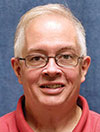Reflection / Sean Gallagher
Indy 500 driver teaches lesson about acknowledging misdeeds
 Some of the clearest memories of my childhood relate to the Indianapolis 500. Part of that is because I lived around the corner in Shelbyville from the late Samuel Amos, who served as a U.S. Auto Club official during the famed race, and practice and qualifying sessions leading up to it.
Some of the clearest memories of my childhood relate to the Indianapolis 500. Part of that is because I lived around the corner in Shelbyville from the late Samuel Amos, who served as a U.S. Auto Club official during the famed race, and practice and qualifying sessions leading up to it.
I spent many an evening in the month of May going to the Amos home and hearing a report from Sam about the day’s happenings.
The Indy 500 still has a prominent place in my memory because of the great racing I’ve appreciated—usually over the radio—over the years. I can still remember when I was 11 years old listening to Paul Page making a great call of the finish of the 1982 race in which Gordon Johncock bested Rick Mears by less than .2 seconds.
Thirty-two years later, I watched this year’s race with my sons at the southern Decatur County home of my in-laws, who can tune into the Cincinnati ABC affiliate that offers a live broadcast.
The finish to this year’s race was as exciting as the one in 1982. Ryan Hunter-Reay finished .06 seconds ahead—less than one-car length—of three-time winner Helio Castroneves. Hopefully decades from now, my sons will recall special memories of this year’s 500 like I do of the races of my childhood.
I hope they also recall this race and other ones because of the lessons that are dramatically illustrated. Over the past few years, I’ve had the chance to reflect on some of these lessons—most of them coming at the finish of the race.
This year, however, it was an incident that happened about 25 laps from the finish that caught my attention. The racers were bunched up, getting ready to go back to green flag racing after clean up from a previous accident.
Hunter-Reay was leading at the time with three cars close behind him battling for second: Townsend Bell, Indianapolis native and pole sitter Ed Carpenter, and James Hinchcliffe. They raced side-by-side as they sped into turn one.
Racing three-wide anywhere at the Indianapolis Motor Speedway is risky. In a corner, it’s usually a sure recipe for a crash. And that’s what happened.
Carpenter and Hinchcliffe touched wheels, spun and crashed into the outside retaining wall. Carpenter was frustrated as he got out of his destroyed car, and he talked about his anger when he was interviewed.
What I was impressed by, however, was Hinchcliffe openly accepting the blame for the accident that took out the hometown hero because he was the driver that came in last to make it three-wide in turn one. “I was the last guy on the scene,” Hinchcliffe said. “I have to take the blame, for sure.”
I’ve seen many interviews with drivers after crashes where they seek to deflect blame away from themselves. Hinchcliffe didn’t do that. He owned up to his role in the accident.
Taking responsibility for our misdeeds is a hard lesson to learn. Believe me, I’ve been trying to teach my boys that for more than a decade. In all honesty, there are times when I’ve forgotten that lesson and needed to re-learn it myself.
Our life of faith in Jesus Christ calls us to this accountability every day. We acknowledge our faults to experience anew the forgiveness of the Lord, which he will never withhold from us when we show sorrow for our sins.
Catholics experience this forgiveness in a special way in the sacrament of reconciliation when a priest, after hearing a penitent confessing his or her sins, becomes a visible channel of Jesus’ loving mercy.
Openly acknowledging our faults before God should lead us to do the same in our relationships with others. At times, this can be difficult for both the person confessing his or her sins and the person who has been hurt by them. But God will help us all in these important moments.
After we own up to our misdeeds, it still may take a long time for our relationships to heal—if they heal at all. I doubt if Carpenter will invite Hinchcliffe over for dinner anytime soon.
But if healing is to happen, repentance of past wrongs is a firm foundation on which it can be built.
(Sean Gallagher is a reporter for The Criterion, newspaper of the Archdiocese of Indianapolis.) †
 Some of the clearest memories of my childhood relate to the Indianapolis 500. Part of that is because I lived around the corner in Shelbyville from the late Samuel Amos, who served as a U.S. Auto Club official during the famed race, and practice and qualifying sessions leading up to it.
Some of the clearest memories of my childhood relate to the Indianapolis 500. Part of that is because I lived around the corner in Shelbyville from the late Samuel Amos, who served as a U.S. Auto Club official during the famed race, and practice and qualifying sessions leading up to it.